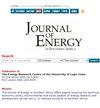热脱盐技术中废热的集成研究进展
IF 0.6
4区 工程技术
Q4 ENERGY & FUELS
引用次数: 0
摘要
海水淡化正日益成为全球提供淡水的关键方法。然而,大多数海水淡化技术都是能源密集型的,而且是由化石燃料驱动的,这加剧了气候变化和其他环境问题。在这方面,可再生能源和能源效率是可持续能源生产和消费的有希望的支柱,余热的回收有助于提高系统的能源效率。根据热源温度(T),废热可分为低温(T<100℃)、中温(100℃~ T<300℃)和高温(T³300℃)三类。关于废热在海水淡化技术中的整合的综述工作很少。本文综述了利用废热驱动热脱盐工艺的研究进展。研究发现,63%的废热流是低品位的,这对于使用低温热源的热脱盐技术来说仍然是令人满意的。截至2018年,已知只有一家由废热驱动的热脱盐厂。缺乏关于废热的数据,特别是在发展中国家,已被确定为这一热能来源推动的海水淡化技术进步的主要挑战。本文还提出并讨论了其他约束条件。本文章由计算机程序翻译,如有差异,请以英文原文为准。
Integration of waste heat in thermal desalination technologies: A review
Desalination is increasingly becoming a crucial method for providing fresh water globally. However, most of the desalination technologies are energy-intensive and driven by fossil fuels that are contributing to climate change and other environmental problems. In this vein, renewable energy and energy efficiency are promising pillars of sustainable energy production and consumption, and the recovery of waste heat helps to augment the energy efficiency of a system. Based on the temperature (T) of the heat source, waste heat can be classified into three categories: low temperature (T<100°C), medium temperature (100°C£T<300°C) and high temp-erature (T³300°C). There is scarcity of review work on the integration of waste heat in desalination technologies. In this study, the progress in the utilisation of waste heat to drive thermal desalination processes has been investigated. It is found that 63% of waste heat streams are of low grade, which is still satisfactory for thermal desalination technologies that run on low-temperature heat sources. As of 2018, there was only one known thermal desalination plant driven by waste heat. Lack of data on waste heat, especially in developing countries, has been identified as a major challenge to the advancement of desalination technologies driven by this source of thermal energy. Other constraints are presented and discussed in this paper.
求助全文
通过发布文献求助,成功后即可免费获取论文全文。
去求助
来源期刊

Journal of Energy in Southern Africa
ENERGY & FUELS-
CiteScore
3.00
自引率
0.00%
发文量
16
审稿时长
6 months
期刊介绍:
The journal has a regional focus on southern Africa. Manuscripts that are accepted for consideration to publish in the journal must address energy issues in southern Africa or have a clear component relevant to southern Africa, including research that was set-up or designed in the region. The southern African region is considered to be constituted by the following fifteen (15) countries: Angola, Botswana, Democratic Republic of Congo, Lesotho, Malawi, Madagascar, Mauritius, Mozambique, Namibia, Seychelles, South Africa, Swaziland, Tanzania, Zambia and Zimbabwe.
Within this broad field of energy research, topics of particular interest include energy efficiency, modelling, renewable energy, poverty, sustainable development, climate change mitigation, energy security, energy policy, energy governance, markets, technology and innovation.
 求助内容:
求助内容: 应助结果提醒方式:
应助结果提醒方式:


